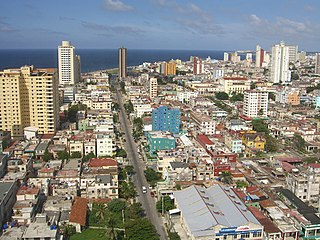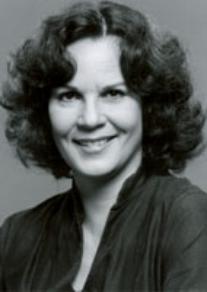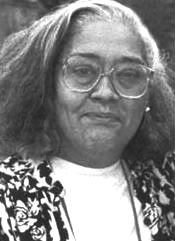Related Research Articles

Havana is the capital and largest city of Cuba. The heart of the La Habana Province, Havana is the country's main port and commercial center. It is the most populous city, the largest by area, and the second largest metropolitan area in the Caribbean region. The population in 2002 was 2,137,847 inhabitants, and its area is 728.26 km2 (281.18 sq mi) for the capital city side and 8,475.57 km2 for the metropolitan zone.
The guaracha is a genre of music that originated in Cuba, of rapid tempo and comic or picaresque lyrics. The word has been used in this sense at least since the late 18th and early 19th century. Guarachas were played and sung in musical theatres and in working-class dance salons. They became an integral part of bufo comic theatre in the mid-19th century. During the later 19th and the early 20th century the guaracha was a favourite musical form in the brothels of Havana. The guaracha survives today in the repertoires of some trova musicians, conjuntos and Cuban-style big bands.
Roberto Fernández Retamar was a Cuban poet, essayist, literary critic and President of the Casa de las Américas. In his role as President of the organization, Fernández also served on the Council of State of Cuba. An early close confidant of Che Guevara and Fidel Castro, he was a central figure in Cuba from the 1959 Revolution until his death in 2019. Fernández also wrote over a dozen major collections of verse and founded the Casa de las Americas cultural magazine.
Pedro Juan Gutiérrez is a Cuban novelist.

Old Havana is the city-center (downtown) and one of the 15 municipalities forming Havana, Cuba. It has the second highest population density in the city and contains the core of the original city of Havana. The positions of the original Havana city walls are the modern boundaries of Old Havana.

Miguel Ángel Solá Vehil is an Argentine actor who has made over 60 film appearances in film and TV in Argentina since 1973. He is traditionally typecast in villain roles.

Ana Margarita Martínez-Casado is a Cuban actress and singer.
The honorary title Hero of the Republic of Cuba is the highest decoration awarded by the Republic of Cuba. It is equivalent to other hero titles common in the Socialist Bloc. The decoration is physically represented with the Gold Star Medal, hanging in a gold plaque enamelled with the colors of the national flag.

Fernando "Papi" Cortés was a Puerto Rican film actor, writer and director. He was born in San Juan, Puerto Rico, but he spent most of his adult life in Mexico City, where he died. On 1932, while in New York City, Fernando Cortés married Puerto Rican childhood friend María del Pilar Cordero, who adopted the stage name of Mapy Cortés. The couple soon traveled to Spain with a Cuban theatrical troupe. They worked on the Spanish stage, radio and film until the outbreak of the Civil War in 1936. Fernando progressively began to take a backseat as actor and baritone and focused on promoting the career of his wife Mapy, who became a noted vedette in Barcelona.

Vladimir Cruz Marrero is a Cuban actor, screenwriter, playwright, film and theatre director. He is perhaps best known for his role in the film Strawberry and Chocolate (1994).
National Prize for Literature is the national literature prize of Cuba. It has been given annually since 1983 and recognizes those writers who have enriched the legacy of Cuban literature. It has been called "the most important award of its kind" in Cuba.
Herberto Dumé is best known for his theater direction.
Magali Alabau is a Cuban-American poet, theater director, and actor. Born in Cienfuegos, Cuba, she has lived in New York since 1966. She co-founded the Spanish-English ensemble Teatro Dúo/Duo Theatre with Manuel Martín Jr. and the lesbian theater Medusa's Revenge with Ana María Simo. She began writing poetry after retiring from theater, and published eight books between 1986 and 2015.
Reynaldo Agustín Miravalles de la Luz, known as Reinaldo Miravalles, was a Cuban actor residing in Miami.

Excilia Saldaña was an Afro-Cuban juvenile literature writer, poet and academic. In 1984, she won the National Union of Writers and Artists of Cuba Special Prize La Rosa Blanca given for the best children's literature of the year for the first time and repeated that award four other times in her career. In 1995, she was a finalist in the International José Martí Prize for children's Literature awarded by the Costa Rican Ministry of Culture and the San Judas Tadeo Foundation. Three years later, her poetry garnered her the Nicolás Guilén Award.
Adria Santana was a Cuban actress best known for her work in the theater.
Alfredo Diez Nieto was a Cuban composer, conductor, and professor. He taught composition at Instituto Musical Kohly, the Amadeo Roldán Conservatory, the National Art School, and the Instituto Superior de Arte in Havana. He founded and conducted the Orquesta Popular de Conciertos. Diez Nieto composed orchestral works including three symphonies and chamber music for various instruments, using and transforming elements from Cuban folk music.
Calixto Álvarez is a Cuban composer.

Laura de la Uz is a Cuban film, television and theatre actress. She appeared in the theatre drama "Un Rayo de Esperanza" in 2020 Cubacultura. She was nominated for Platino Award for Best Actress twice.

Isabel Moreno Pérez was a Cuban actress. She worked in Cuba, Venezuela, and the United States, where she later resided. She is known for playing characters such as Teresa Trebijo, La Santiaguera, Chachi, La Mexicana, Soledad Mendoza, Cachita, and Bernarda Alba.
References
- 1 2 3 4 5 6 "Fallece el dramaturgo Abelardo Estorino" [The Dramatist Abelardo Estorino Passes Away]. El Nuevo Herald (in Spanish). Havana. EFE. 23 November 2013. Archived from the original on 24 November 2013. Retrieved 15 January 2019.
- 1 2 3 4 5 6 7 8 "Vida y obra de Abelardo Estorino" [Life and Work of Abelardo Estorino] (in Spanish). National Prize for Literature. Archived from the original on 1 January 2016. Retrieved 15 January 2019.
- 1 2 3 Guerra, Wendy (24 November 2013). "Dos grandes dramaturgos cubanos" [Two Great Cuban Playwrights]. El Mundo Habáname (in Spanish). Retrieved 16 January 2019.
- 1 2 3 4 5 Vicent, Mauricio (25 November 2013). "Abelardo Estorino, en el olimpo del teatro cubano" [Abelardo Estorino, on the Olympus of Cuban Theater]. El País (in Spanish). Retrieved 16 January 2019.
- ↑ Cotter, Holland (13 August 2010). "Raúl Martínez: 'Eagerly Awaiting'". The New York Times . Retrieved 16 January 2019.
- ↑ Bleys, Rudi (27 October 2000). Images of Ambiente: Homotextuality and Latin American Art, 1810–today. A & C Black. p. 73. ISBN 9780826447234 . Retrieved 16 January 2019– via Google Books.
- ↑ Rojas Mirabal, Amalia (5 March 2011). "En Cuba, Vidas paralelas" [In Cuba, Parallel Lives]. La Jiribilla (in Spanish). Havana. Archived from the original on 22 October 2018. Retrieved 16 January 2019.
- ↑ "El peine y el espejo". Cuban Theater Digital Archive. University of Miami . Retrieved 15 January 2019.
- 1 2 3 4 5 6 "Biografía de Abelardo Estorino" [Biography of Abelardo Estorino]. Granma (in Spanish). Retrieved 16 January 2019.
- ↑ "Abelardo José Estorino López". John Simon Guggenheim Memorial Foundation . Retrieved 16 January 2019.
- ↑ Salinas, Mike. "HOLAtta Accolades Goin' On". Backstage . Retrieved 15 January 2019.
- ↑ "Repertorio Español lamenta el fallecimiento del escritor cubano Abelardo Estorino" [Repertorio Español Mourns the Death of the Writer Abelardo Estorino]. Fronteras Magazine (in Spanish). 21 December 2013. Retrieved 16 January 2019.
- ↑ Motola Pedroso, Patricia (March 2014). Apuntes para la Historia de la Academia Cubana de la Lengua [Notes on the History of the Academia Cubana de la Lengua](PDF) (in Spanish). Havana: Academia Cubana de la Lengua. p. 76. Retrieved 15 January 2019.